’Tis the season to transform wastewater treatment into gingerbread
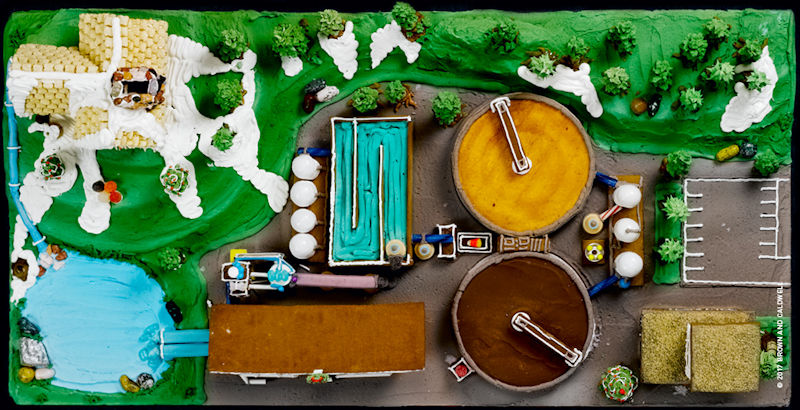
While working for Brown and Caldwell (Walnut Creek, Calif.), Sean Porter, currently the West region stormwater program manager for Apex (Rockville, Md.), treated his San Diego office to a holiday treat, a water resource recovery facility made out of gingerbread. Photo courtesy of Brown and Caldwell.
Thinking of wastewater treatment does not usually evoke the sights and smells of Christmas. But as many of the world’s creative minds know, combining contrasting concepts can produce memorable art. That’s exactly what Sean Porter, currently the West region stormwater program manager at Apex (Rockville, Md.), did when he decided to create a water resource recovery facility (WRRF) out of gingerbread.
Inspiration from advanced wastewater treatment

In December 2016, Porter put his pastry-chef skills to use by turning wastewater into holiday-themed art. Photo courtesy of Brown and Caldwell.
While working as principal scientist at Brown and Caldwell (Walnut Creek, Calif.) in San Diego, Porter decided to create a gingerbread house for the lobby of his office. As he began thinking about potential designs in December 2016, inspiration struck: wouldn’t it be “interesting” to do something that correlated to the company’s business: wastewater?
Porter remembered that the company was heavily involved in the Pure Water San Diego program. This program runs nonpotable reuse water from WRRFs through advanced disinfection, microfiltration, and reverse osmosis before releasing it into surface water reservoirs that feed potable water treatment facilities. Showing this process using holiday treats became Porter’s goal.
“I’m going to take this wastewater environment and I’m going to turn it into something that denotes Christmas,” Porter said. “The combination worked.”
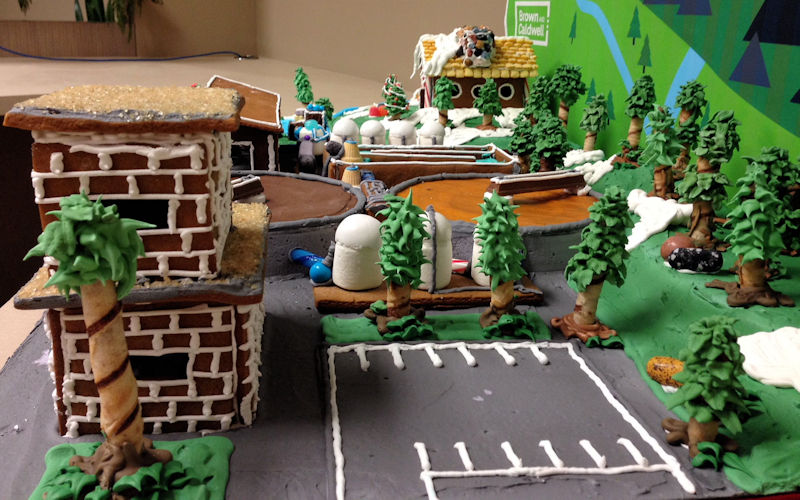
The sweet-piece incorporated the many elements of wastewater treatment for reuse including an operations center complete with parking lot for “employees,” Porter said. Photo courtesy of Brown and Caldwell.
Before beginning, Porter, who had worked his way through college as a baker and pastry chef, needed a little more background information. “I’m not a wastewater guy, I’m a stormwater guy,” he said. Luckily, his office is filled with experts. He asked one of the wastewater engineers to explain the wastewater treatment process to help him figure out how to lay out his gingerbread WRRF on its foam board. Then, he began his covert candy construction.
Candy construction shows the complete cycle
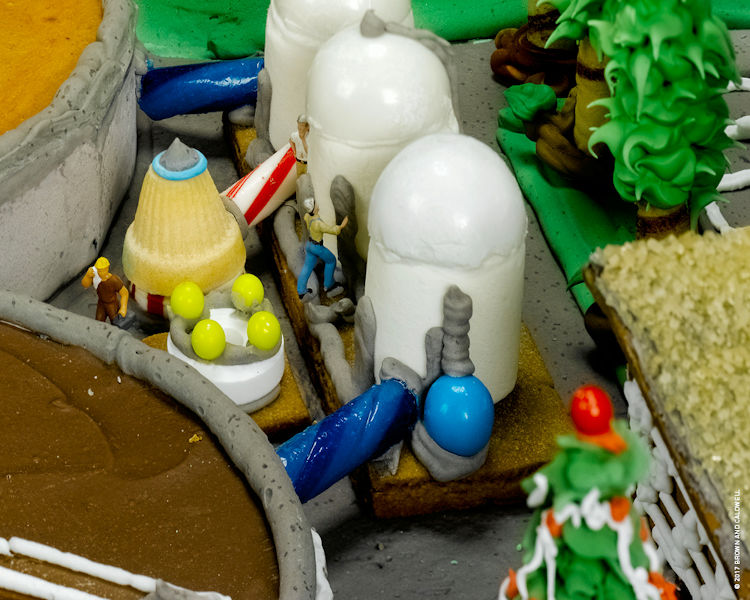
Various pieces of candy were used to show wastewater treatment processes such as chlorine tanks made of marshmallow topped with gumballs. Photo courtesy of Brown and Caldwell.
Porter introduced the office to his creation about 3 weeks after starting. He spent a total of about 30 to 40 hours working on the project in the evenings after his two children went to sleep. The entirely edible product spanned about 0.6-m (2 ft)-wide by 1.2-m (4 ft)-long and would cost about $2500 if he were to sell it as a professional baker, he said.
The gingerbread WRRF consisted of a “hodge podge” of different sweets put together to “represent a process,” Porter said. The display consists of
- an operations center, contact basin, and house made of the traditional gingerbread and royal icing;
- chlorine tanks made of marshmallows and gumballs;
- pipes represented by colored candy canes as well as purple and blue gum cigars and white candy cigarettes;
- a primary and a secondary clarifier filled with Rice Krispies TreatsTM;
- skimmers made of decorated Kit Kat® bars;
- an advanced disinfection process consisting of Starbursts®, Baby Ruth®, marshmallows, and gumballs; and
- a reverse osmosis assembly with cells consisting of candy cigarettes.
To show advanced wastewater treatment, Porter used supplies purchased at local stores, candy from his children’s leftover Halloween stash and the office candy jar, and contributions from a coworker’s recent trip to Japan.
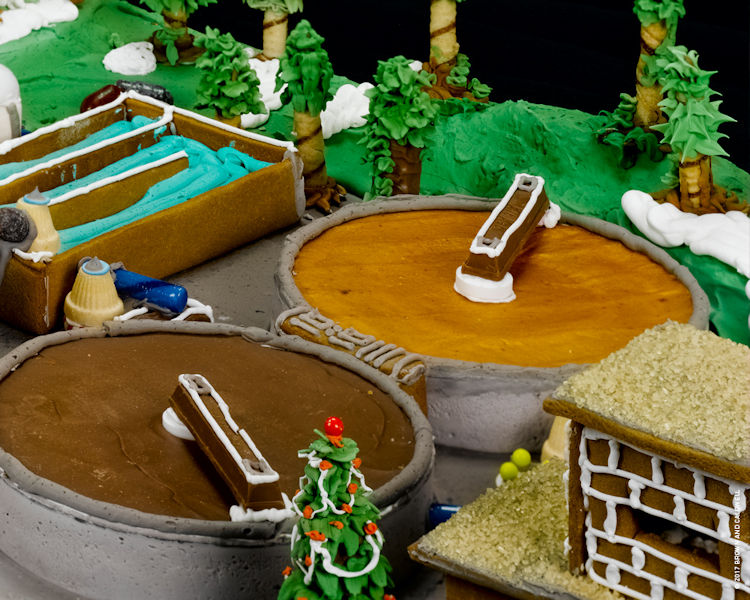
Porter showed the process of water being cleaned in the clarifiers by using chocolate icing to show dirty water in the primary clarifier and a mango-flavored Fruit Roll-UpTM to show lighter, “cleaner” water in the secondary clarifier. Photo courtesy of Brown and Caldwell.
The primary clarifier is topped with chocolate to show dirty water and the secondary clarifier is topped with a mango-flavored Fruit Roll-UpTM to show the process of water being cleaned, Porter said. A purple candy cigar was used to represent the “purple pipe” that holds reclaimed water, and the blue candy cigar shows clean water being released to a reservoir. A gingerbread house complete with French Toast CrunchTM shingles withdraws water from the blue icing reservoir to represent “the whole cycle of the wastewater flow,” Porter said. After finishing, Porter decorated with festive touches such as Christmas trees, snow, candy canes, and wreaths.
Gingerbread WRRF goes on tour
Porter revealed his completed gingerbread WRRF in his office’s lobby in late December. But it stayed there for a few days only. A senior engineer decided that the City of San Diego’s Wastewater Department that managed the Pure Water program needed to enjoy the construction as well. City staff put the display in their office lobby for a couple of weeks.
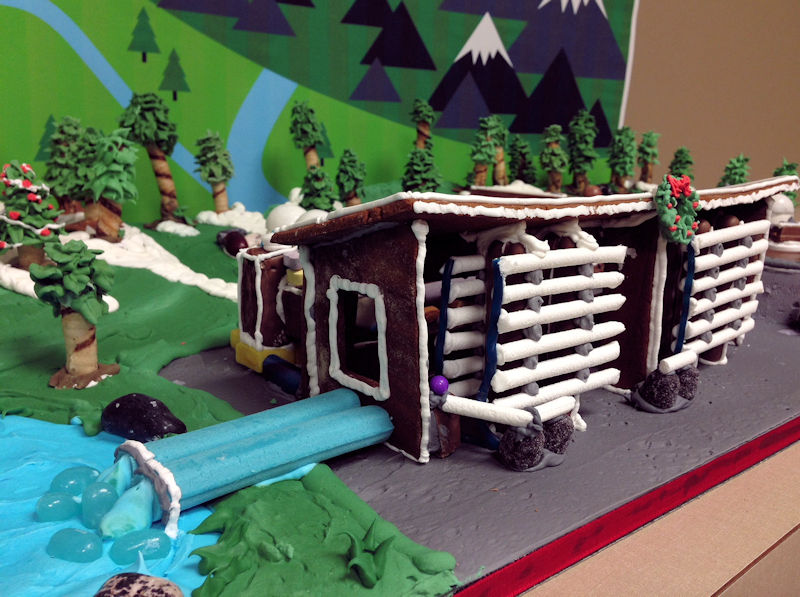
The reverse osmosis assembly was constructed using candy cigarettes inside a gingerbread shed. Cleaned “water” is released by blue candy cigar pipes into a blue icing reservoir. Photo courtesy of Brown and Caldwell.
The construction then was moved to the City of San Diego’s Pure Water demonstration project building. The building features a large lobby with windows overlooking the water reuse project, which is open to the public for tours. Staff working in the building and visitors taking tours were able to enjoy the festive construction for a few weeks. Brown and Caldwell gave the construction to a photographer for a photo-shoot before giving it back to Porter. “Everybody thought it was great,” he said.
— Jennifer Fulcher, WEF Highlights








March 29, 2018
Featured